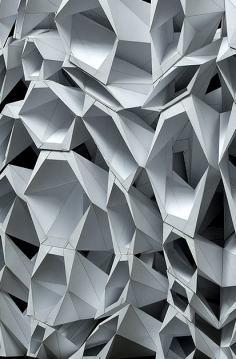OLIVER TESSMANN
blurring structure
source: olivertessmannwordpress
Oliver Tessmann is an Assistant Professor (tenure track) in the School of Architecture and the Built Environment, KTH Stockholm. His teaching and research in the Architectural Technology Group revolves around computational design and digital manufacturing in architecture.
He has been a Guest Professor at Staedelschule Architecture Class (SAC) in Frankfurt, heading the specialization “Architecture and Performative Design”. He worked with the engineering office Bollinger + Grohmann in Frankfurt at the interface between architecture and engineering. After graduating in 2001 at the University in Kassel he was working with Coop Himmelb(l)au in Mexico and Vienna and Bernhard Franken in Frankfurt. In 2008 Oliver Tessmann received a doctoral degree after four years of research in the field of “Collaborative Design Procedures for Architects and Engineers” at the University of Kassel. The research sought for novel strategies to use structural analysis as a design driver in architecture by establishing digital interfaces between the disciplines. His work has been published and exhibited in Europe, Asia and the US.
.
.
.
.
.
.
.
source: kthse
In 2012 Oliver Tessmann has taken up a new position as assistant professor in the School of Architecture and the Built Environment, KTH, Stockholm, in Architectural Technology. His teaching and research revolves around computational design and digital manufacturing in architecture. See more of Oliver’s work here.
He has been a Guest Professor at Staedelschule Architecture Class (SAC) in Frankfurt, heading the specialization “Architecture and Performative Design”. He worked with the engineering office Bollinger + Grohmann in Frankfurt at the interface between architecture and engineering. After graduating in 2001 at the University in Kassel he was working with Coop Himmelb(l)au in Mexico and Vienna and Bernhard Franken in Frankfurt. In 2008 Oliver Tessmann received a doctoral degree after four years of research in the field of “Collaborative Design Procedures for Architects and Engineers” at the University of Kassel. The research sought for novel strategies to use structural analysis as a design driver in architecture by establishing digital interfaces between the disciplines. His work has been published and exhibited in Europe, Asia and the US.
.
.
.
.
.
.
.source:
In recent years geometrical models became increasingly augmented and pre-rationalized in regards to computer-numerically-controlled fabrication techniques. blurring structures aims to integrate a further crucial aspect of architectural design: the structural performance of building components as design driver from early on. One promising way to blur the realm of structural analysis (quantitative data) with qualitative architectural design approaches is seen in the use of macro-scripting and programming.
In the studio participants designed and implemented their own modular system and propagated it into a three dimensional spatial configuration. During the generative process they used a custom-made tool that interfaces the 3D model with structural analysis software and informs the geometry with the internal forces present in the system.
.
.
.
.
.
.
.
source: olivertessmannwordpress
In recent years geometrical models became increasingly augmented and pre-rationalized in regards to computer-numerically-controlled fabrication techniques. blurring structures aims to integrate a further crucial aspect of architectural design: the structural performance of building components as design driver from early on. One promising way to blur the realm of structural analysis (quantitative data) with qualitative architectural design approaches is seen in the use of macro-scripting and programming.
In the studio participants designed and implemented their own modular system and propagated it into a three dimensional spatial configuration. During the generative process they used a custom-made tool that interfaces the 3D model with structural analysis software and informs the geometry with the internal forces present in the system.


